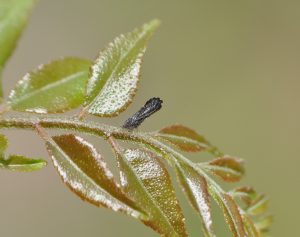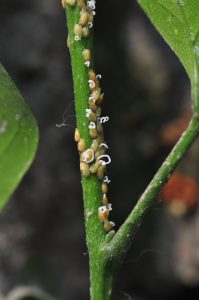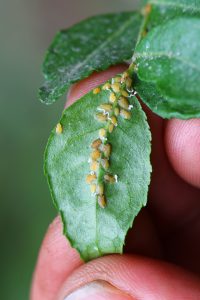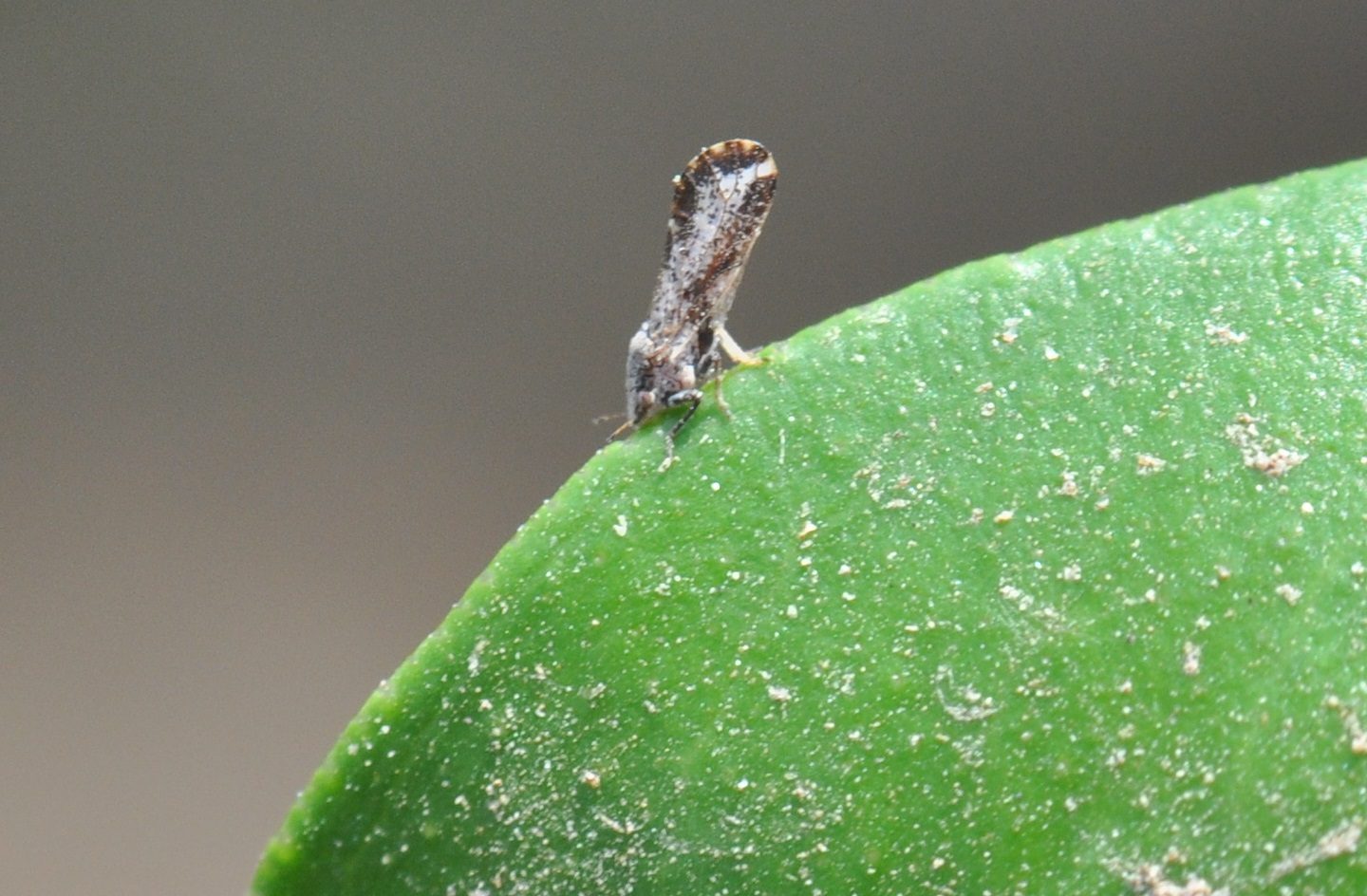Diaphorina citri
Crop: Citrus
Why is it a problem? The Asiatic citrus psyllid (ACP) is the primary vector of the devastating disease, huanglongbing (HLB). Management of the vector is important to slow the spread of the disease within and between orchards. At high densities direct feeding can also damage plants, reducing their growth rates. However, unlike the green citrus psyllid direct damage is rarely, if ever, sufficient to require management.
Where and when is it a problem? It is common in most or all orchards up to about 1200 masl, although it can be present up to at about 1450 masl.
IDENTIFICATION


Adults are small (about 2.4 mm long) and brownish. They feed with their heads down, almost touching the surface of the leaf. Because of the shape of their head, their bodies are lifted off the leaf at about a 30-45° angle. The adults are weak flyers, and they jump or fly when disturbed. Eggs are about 0.3 mm long and almond-shaped with a thick base that narrows towards the distal end with a curve. Newly laid eggs are pale and then turn yellow and subsequently orange just before hatching. Eggs are laid on young tender buds and shoots.


Nymphs are generally yellowish-orange. The later instars have large wing pads. There are five nymphal stages that look similar, but increase in size after each moult. The feeding nymphs produce waxy tubules that direct the honeydew away from their bodies. They move in a slow, steady manner and flick their abdomens upward when disturbed.
SYMPTOMS
Direct feeding can stunt and twist young shoots and cause leaf curling. Growing tips can present a rosette appearance. Psyllids also secrete honeydew, which encourages the growth of sooty mould. Leaves can drop prematurely. Serious damage to growing points can occur, which can lead to dwarfing and blossom and fruitlet drop.
Confusion with other pests: There are three psyllids on citrus in Bhutan. Adults are easily identified by colour and pattern. As the common names suggest, adult green citrus psyllids (Cacopsylla heterogena) are green, black psyllids (Diaphorina communis) are black, and the Asiatic citrus psyllid, also known as the brown psyllid, is brown. The nymphs of the Asiatic citrus psyllid and green citrus psyllid look similar and expert assistance will be required to identify them.
BIOLOGY
Lifecycle: Adults live up to 75 days and females can lay from 630 to 1230 eggs. Eggs may hatch within 4 days during warm summer months but may take longer than 20 days during colder days in winter. There are five nymphal stages, all of which feed exclusively on new growth. Depending on the prevailing temperatures, total nymphal development can take 11 to 25 days. Females lay their eggs on the tips of growing shoots or in the crevices of unfolded “feather flush” leaves.
Adults as well as the fourth and fifth instar nymphs can acquire the HLB bacterium. Adults can acquire the HLB bacterium within 15 minutes of feeding on infected plants. Adults that acquired the bacterium in their nymphal stage remain infective throughout their life span, and can transmit the pathogen more efficiently than those adults which did not acquire the pathogen in their nymphal stage. Longer feeding on infected plants results in a higher rate of pathogen acquisition.
Dispersal: The Asiatic citrus psyllid is a weak flier. However, that is sufficient to move the HLB bacterium between trees within an orchard and between neighbouring orchards. Long-distance dispersal of the psyllid is human-assisted, such as through the movement of citrus plants (bud wood, grafted trees and rootstock seedlings). These can carry eggs and nymphs if not treated which can then go on to infect other plants.
When can damage be expected? This pest is more common at altitudes up to about 1200 masl. It feeds on new growth so will be most abundant and evident during the spring flush.
Hosts: The Asiatic citrus psyllid occurs on all citrus species. It is also observed on Bergera koenigii (curry leaf). It feeds and develops on Murraya paniculata (orange jasmine) and Murraya elongata, which are present in Bhutan.
MANAGEMENT PRACTICES
Management of the Asiatic citrus psyllid is entirely focussed on keeping populations low within the orchard, thereby containing or slowing the spread of HLB within and between orchards. In addition, citrus stock needs to be clean of psyllids prior to movement. Management of Asiatic citrus psyllid in the context of HLB requires that management be conducted at a community level, especially where many orchards exist in close proximity.
Monitoring
Monitoring should be conducted by visually inspecting the new flush of citrus on which the psyllid is most likely to be feeding. Special attention should be focussed on locating damage symptoms, including twisted and curling shoot tips, sooty mould, and white waxy deposits on the leaves. The cause of damage should be confirmed by looking for eggs, nymphs or adults. Adults can readily be seen with the naked eye but are easily disturbed. Young nymphs and eggs are hard to see without a hand lens. Yellow or green sticky cards can be used as an additional method for detecting adult psyllids. Alternately, adults can be collected by tapping branches onto white or blue coloured trays or household bowls.
Effect of variety
This has not been studied in Bhutan.
Non-chemical management
Managing within the orchard
- There are currently no known non-chemical methods for controlling Asiatic citrus psyllid. Mineral Oil may be effective, but is yet to be tested.
- The risk of psyllids vectoring HLB pathogen within the orchard can largely be avoided by planting citrus above about 1200 m asl using plants that are free of psyllids and disease.
- Planting orchards away from other orchards and house trees could make the management of Asiatic citrus psyllid simpler, and greatly reduce the risk of inter-orchard movement of the psyllid, and therefore HLB.
- Edge effects have been noted, with Asiatic citrus psyllid being most abundant on trees around the edge of orchards.
Chemical management
Management prior to movement of citrus stock
- Only psyllid-free, healthy plant materials should be transported.
- All planting materials should be treated with contact or systemic insecticide e.g., Chloropyrifos (4ml per litre of water) or Dimethoate (at 2 ml per 1 litre of water).
- Contact insecticides (Chloropyrifos) can be used at least 7-10 days before transportation while Dimethoate can be used at least 21 days prior to movement to ensure that they are free of all psyllid life stages.
Management within the orchard
- Insecticides are currently the only way to reduce psyllid populations within the orchard.
- Timing of the chemical spray (systemic insecticide: Dimethoate at 2 ml per 1 litre of water) is vital. It should coincide with the peak activity of the psyllid, which is during the flush period. This will vary with locality. A second spray should be applied after about three weeks.
Version: NPPC 2017. Asiatic citrus psyllid V1.0. Bhutan Pest Factsheet. www.PestsofBhutan.nppc.gov.bt. Date produced: 14 April 2017. Contact: nppcsemtokha@gmail.com
Image acknowledgements: GAC Beattie/Namgay Om



